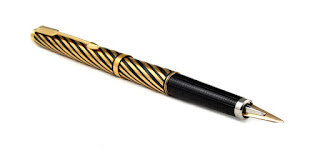 |
| Parker 180 'Torsade' Fountain Pen |
 The Parker 180 Torsade/spiral fountain pen was a limited production pen for the high end Jewelry Store market in Europe. The design of the Torsade (torsade being the French word for 'twist') is reminiscent of a barber pole or candy-stripe. It's design was created by incising alternating width groove spirals in the pen base metal. Parker coated the pen with a charcoal grey enamel lacquer, and polished the pen so the enamel lacquer only remained in the grooved spirals.
The Parker 180 Torsade/spiral fountain pen was a limited production pen for the high end Jewelry Store market in Europe. The design of the Torsade (torsade being the French word for 'twist') is reminiscent of a barber pole or candy-stripe. It's design was created by incising alternating width groove spirals in the pen base metal. Parker coated the pen with a charcoal grey enamel lacquer, and polished the pen so the enamel lacquer only remained in the grooved spirals.The effect of the lacquer and spirals is stunning, and provides the pen with a jeweled appearance. The trim of the pen is very similar to that of the Parker 75. The clip is the identical arrow clip that appears on the Parker 75, and the cap tassie is a similar beehive tassie, with a slightly different indentation from that of the later Parker 75 tassie. The barrel tassie is unique to the Parker 180. Date coding of 'UC' on cap band is 2nd quarter 1981 production

The Parker 180 is a slim pen, the nib style is quite unique -- it is flat and triangular in shape. The nib is a 14K solid gold fine point French nib, with the proper French gold marks on the nib. The designation of this pen, Parker '180' relates to the nib's flat design and ability to write in two different line styles. By rotating the pen in-hand through 180 degrees, the writer is provided with nib having two distinctly different degrees of flex.

We have examined the pen and could not find any defects in the finish. Pen is supplied in original Parker presentation case and like the pen it is in immaculate condition.This factor indicates that the pen was either not used or rarely used. The enamel appears to be the same as it was when it left the factory. We would rate the pen as in Near Mint to Mint condition. This pen is a superior representation of the Heritage series 180s and would make a worthy addition to any Parker fountain pen collection.
 Whilst determining the providence of this pen, we were advised by a renowned authority on Parker pens that it was probably "a test run". A similar Parker 180 Torsade sold on e.bay in June 2012 for $552.
Whilst determining the providence of this pen, we were advised by a renowned authority on Parker pens that it was probably "a test run". A similar Parker 180 Torsade sold on e.bay in June 2012 for $552.As with all Hepworth Dixon vintage and classic pens, we have cleaned, fully serviced and write tested this pen. It is now available to purchase from our website.
For further information and price, this pen can viewed on Hepworth Dixon website:
www.hepworthdixon.com/classic_fountain_pens.html


















